FRIDAY, AUGUST 21
■ Spot the crescent Moon low in the west-southwest in twilight. Look to its left by about 16° for Spica twinkling into view, as shown below. Spica, usually considered a star of spring, is heading down and out for the year.
Much closer to the Moon (for the Americas) is fainter Gamma Virginis, shown on the plot below. They're just a degree or two apart as seen at the times of dusk for North America.
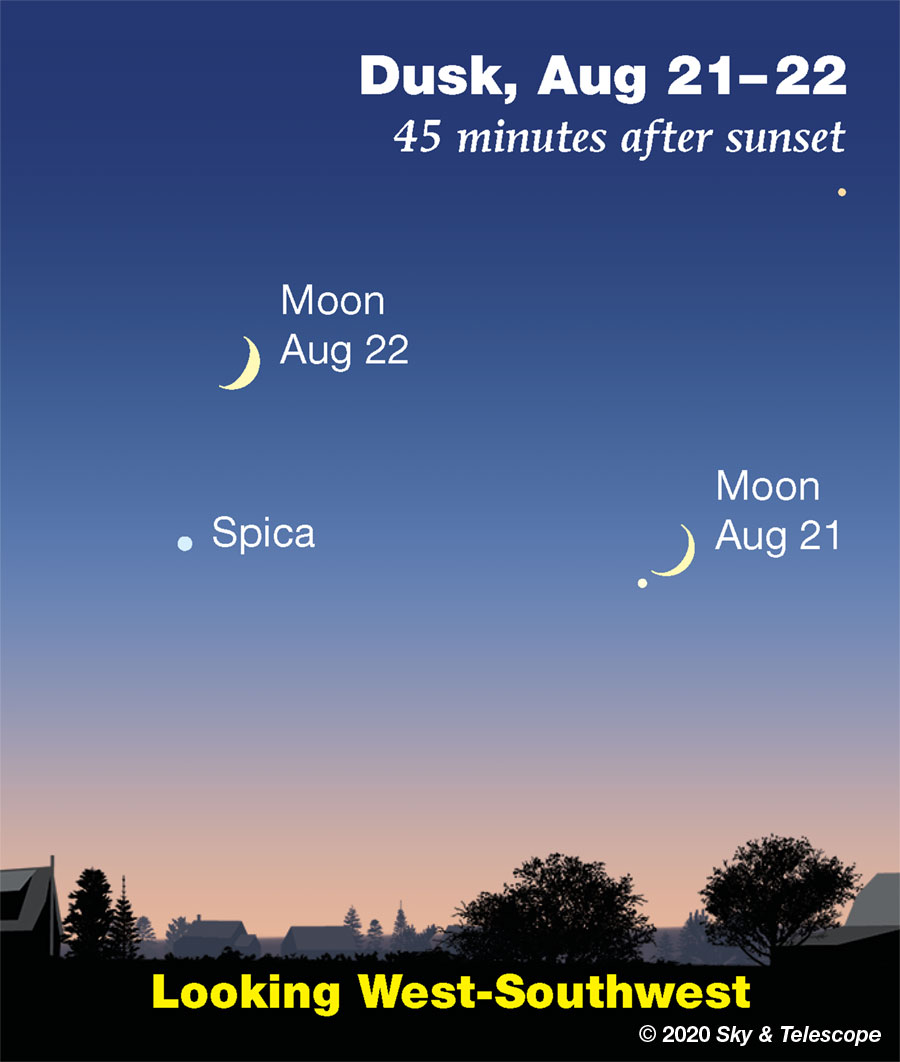
■ Double shadow transit on Jupiter. For telescope users in western North American late Friday night, Io and Ganymede are both casting their tiny black shadows onto the face of Jupiter from 11:32 p.m. to 1:20 a.m. Pacific Daylight Time.
SATURDAY, AUGUST 22
■ Look below the Moon at nightfall for Spica, as shown above. They're 5° or 6° apart at dusk in North America.
■ Late on these evenings of late summer, Fomalhaut, the Autumn Star, makes its inevitable appearance above the southeast horizon. Its rising time will depend on where you live. But by 10 or 11 p.m. you should have no trouble identifying it low in the southeast if you have a good low view in that direction. No other 1st-magnitude star is anywhere nearby.
SUNDAY, AUGUST 23
■ Whenever bright Vega crosses nearest your zenith, as it does soon after dark now, you know that the Sagittarius Teapot is at its highest due south.
Two hours later when Deneb crosses closest to the zenith, it's the turn of little Delphinus and boat-shaped Capricornus down below to stand at their highest due south.
MONDAY, AUGUST 24
■ As dusk turns into night, look left of the Moon for the near-vertical row of stars marking the head of Scorpius. Antares and its two outrigger stars shine a little farther left. And see tomorrow's entry about the telescopic double stars awaiting you here.
■ The brightest star high in the southeast these evenings, high to the upper left of Jupiter and Saturn, is Altair. Look for little orange Tarazed above it by a finger-width at arm's length. Altair is only 17 light-years away. Tarazed (Gamma Aquilae) is a red giant about 400 light-years in the background.
Hardly more than a fist-width to Altair's left is delicate Delphinus, the Dolphin, leaping left: toward the east.
Slightly less far above or upper left of Altair, look for smaller, fainter Sagitta, the Arrow. It too points east.
TUESDAY, AUGUST 25
■ First-quarter Moon (exact at 1:58 p.m. EDT). Come nightfall, the Moon shines just above Antares and the head of Scorpius.
As soon as you're done with the Moon in your scope, check out the double stars Beta Scorpii (the top of the row of three head stars) and fainter Nu Scorpii right near it. Beta this evening is about 4° right of the Moon, easy to spot with a total magnitude of 2.6. It's a fine double for any telescope: separation 13 arcseconds, magnitudes 2.8 and 5.0.
Upper left of Beta by 1.6° is Nu Scorpii, separation 41 arcseconds, magnitudes 3.8 and 6.5 . In fact it's a telescopic triple. High power in good seeing reveals Nu's brighter component itself to be a close binary, separation 2 arcseconds, magnitudes 4.0 and 5.3, aligned almost north-south.
WEDNESDAY, AUGUST 26
■ This evening right after dusk, the Saturn-Jupiter line points straight at the Moon to their left. Lower left of the Moon is Antares.
And look down below the Moon, by about 14° and just a bit left, for the star pair known as the Cat's Eyes: Lambda and Upsilon Scorpii in the Scorpion's tail. They're 0.6° apart and canted at an angle. They're unequal (magnitudes 1.6 and 2.7); the cat is winking. The brighter one, on the upper left, is Lambda. Both are blue-white supergiants, 700 and 500 light years away respectively.
THURSDAY, AUGUST 27
■ The waxing gibbous Moon shines due south at the end of twilight, still to the right of Jupiter and Saturn and almost in line with them. The Moon is poised just above the lid of the Sagittarius Teapot. Can you can see the Teapot stars through the moonlight? If not binoculars do the trick, but only a smallish part of the Teapot will fit in their view at once.
■ Ceres, the first asteroid discovered (in 1801) is at opposition tonight in southern Aquarius at magnitude 7.7. It's about 6° north-northeast of 1st-magnitude Fomalhaut, your easy starting point for a careful star hop late these nights to identify Ceres using the finder chart in the August Sky & Telescope, page 50. Ceres remains about that bright all this week and next as it creeps along.
FRIDAY, AUGUST 28
■ Jupiter shines just a couple degrees above the gibbous Moon this evening for North America; see the twilight view below. To their left, Saturn waits its turn.
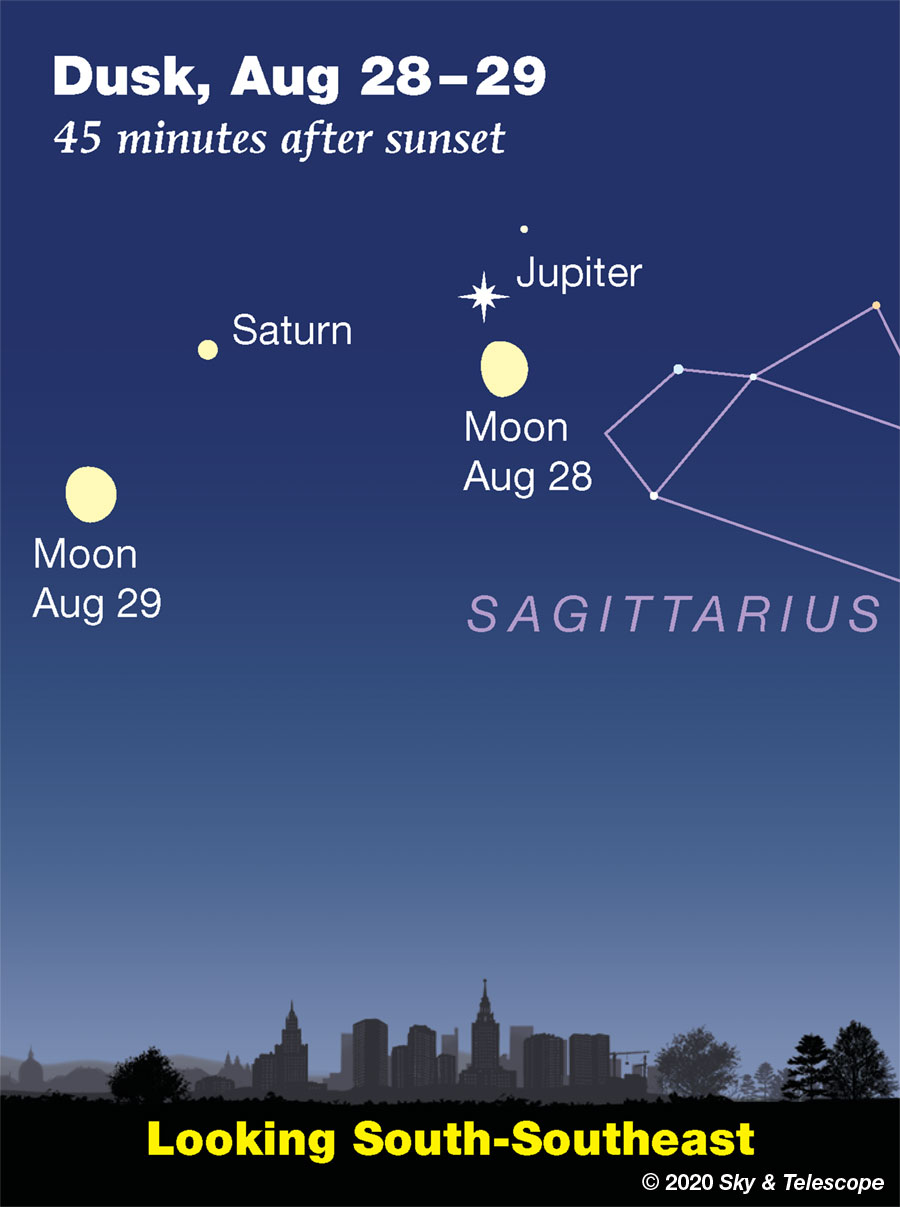
SATURDAY, AUGUST 29
■ Now the eastward-marching Moon shines closer to Saturn than to Jupiter, as shown above. The three are, of course, at very different distances: The Moon is 1.3 light-seconds from you, Jupiter is currently 37 light minutes distant, and Saturn is 77 light-minutes.
This Week's Planet Roundup
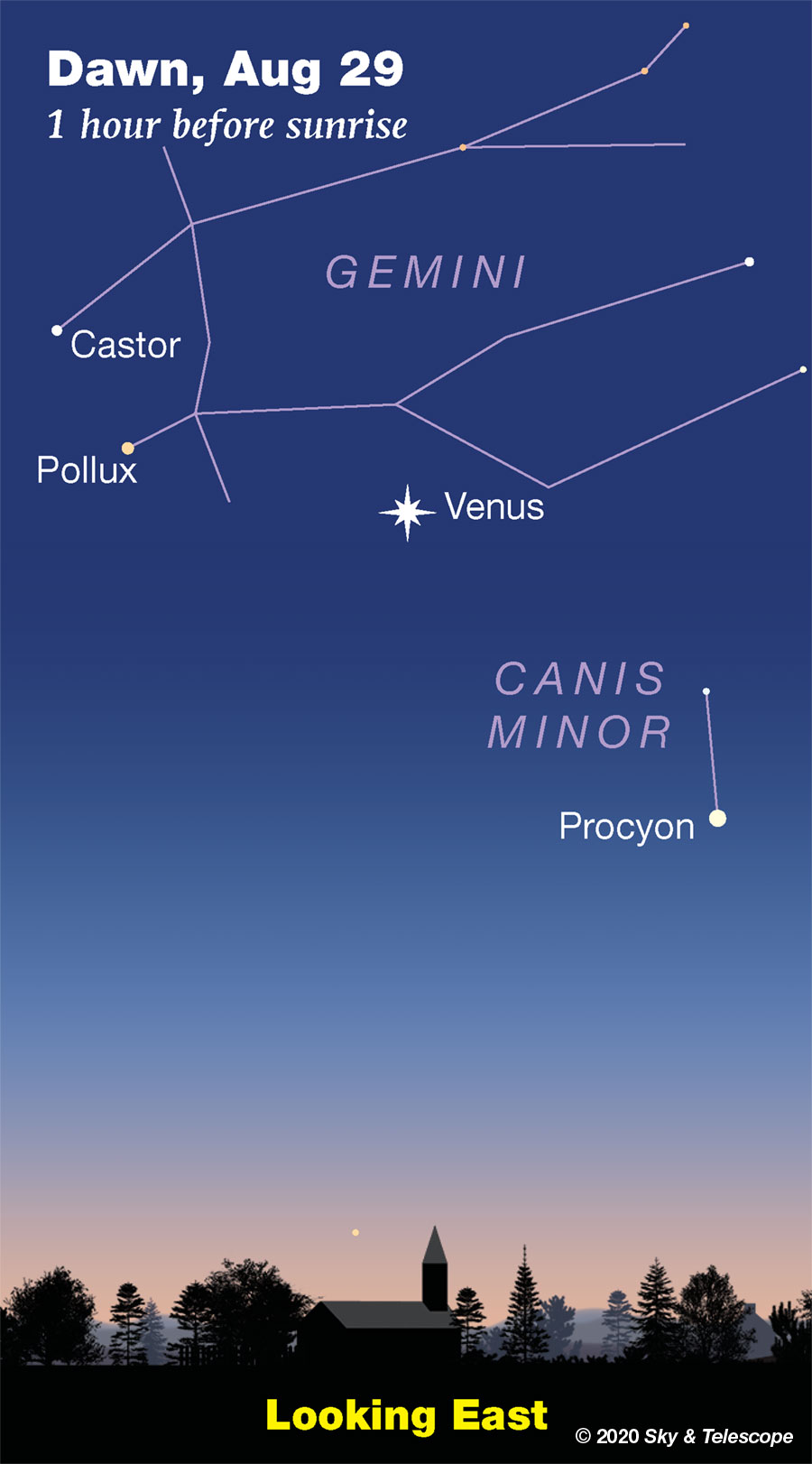
Mercury is hidden in the glare of the Sun.
Venus (magnitude –4.3, in Gemini) rises in deep darkness about two hours before dawn begins, a weird UFO of a thing in the east-northeast. By the time dawn gets under way, Venus blazes brightly high in the east as shown above.
Pollux and Castor are currently left if it, and Procyon is to its lower right, as shown. Spot Orion farther to Venus's right. High above or upper left of Venus is bright Capella.
In a telescope Venus is just past dichotomy: slightly more than half lit.
Mars rises in the east less than an hour after the end of twilight. It emerges bright (magnitude –1.6) and strongly orange like a far-off bonfire. Where will it come up? Watch the horizon far below the Great Square of Pegasus.
Mars climbs higher all through the night. By the beginning of dawn Mars shines grandly high and bright in the south, now a high-blown firespark. It's near the dim Knot of Pisces.
In a telescope this week Mars grows from 17½ to 18½ arcseconds in apparent diameter. That's already bigger than it appears at many oppositions, but we're still approaching Mars as Earth speeds along our faster orbit around the Sun. When we catch up to and pass Mars at opposition in early October, it will appear 22.6 arcseconds wide and will shine at a Jupiter-bright magnitude –2.6.
Mars is still gibbous, 90% sunlit. Look for its white South Polar cap, possible clouds especially near the limb, and subtler dark surface markings. To get a map of the side facing us at the date and time you'll observe, use our Mars Profiler. The map there is square; remember to mentally wrap it onto the side of a globe. (Features near the map's edges become very foreshortened.)
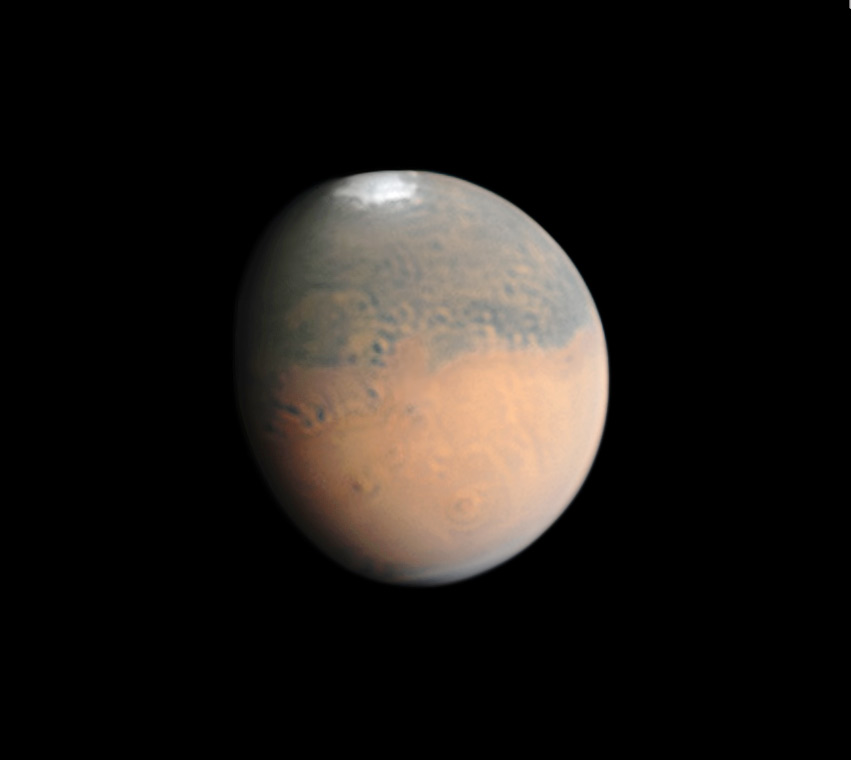
Jupiter and Saturn (magnitudes –2.6 and +0.3, respectively) shine in the south-southeast in twilight. They're highest in the south, for sharpest telescopic viewing, shortly after dark. Jupiter is the brightest; Saturn is 8° to its left.
They're perfectly horizontal right around the end of twilight. Lower right of Jupiter after dark is the handle of the Sagittarius Teapot.
Follow the telescopic interplay of Jupiter with its moons and their shadows, and find all the transit times of Jupiter's Great Red Spot, in the Celestial Calendar section of the August Sky & Telescope, page 50.
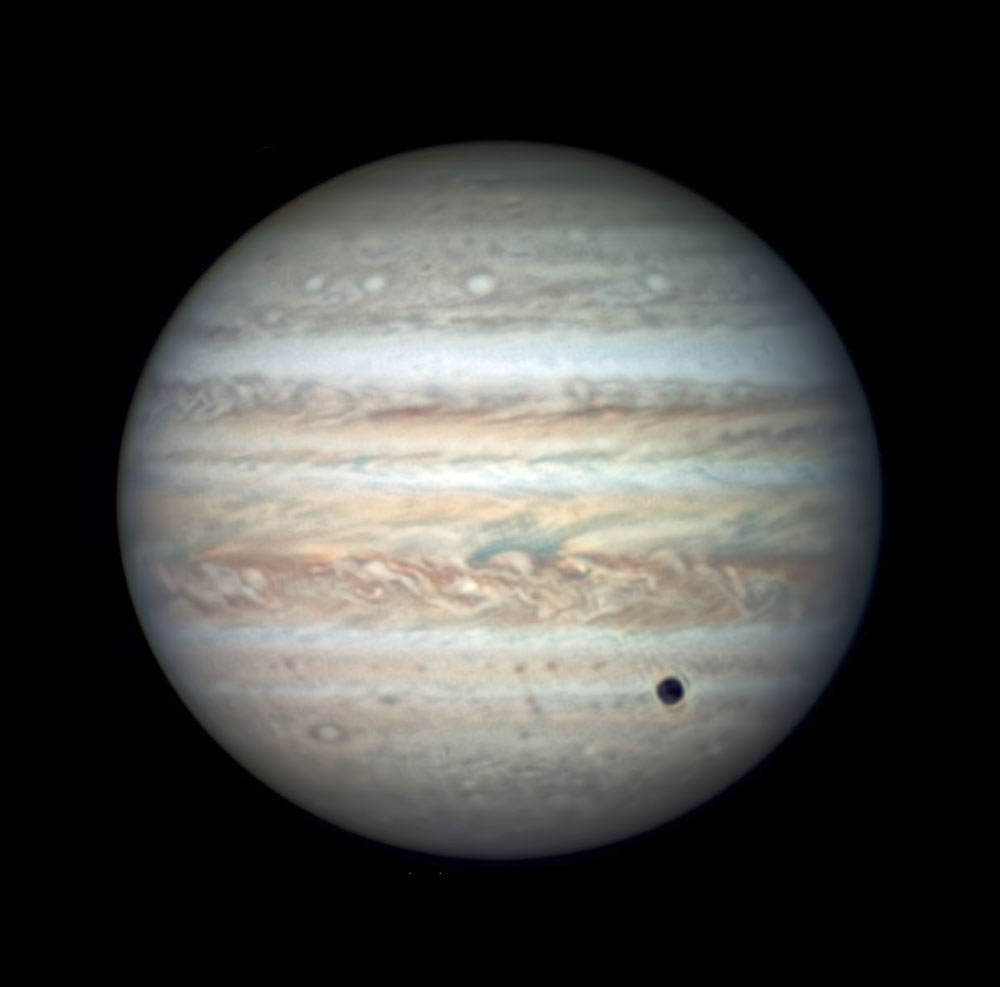
Writes Go, "This is the region [following] the Great Red Spot. The North Equatorial Belt is very active in this region; complex rifts and [white] outbreaks. The South Equatorial Belt is very pale in this region." Callisto is seen in front of the narrow, white North Temperate Zone.
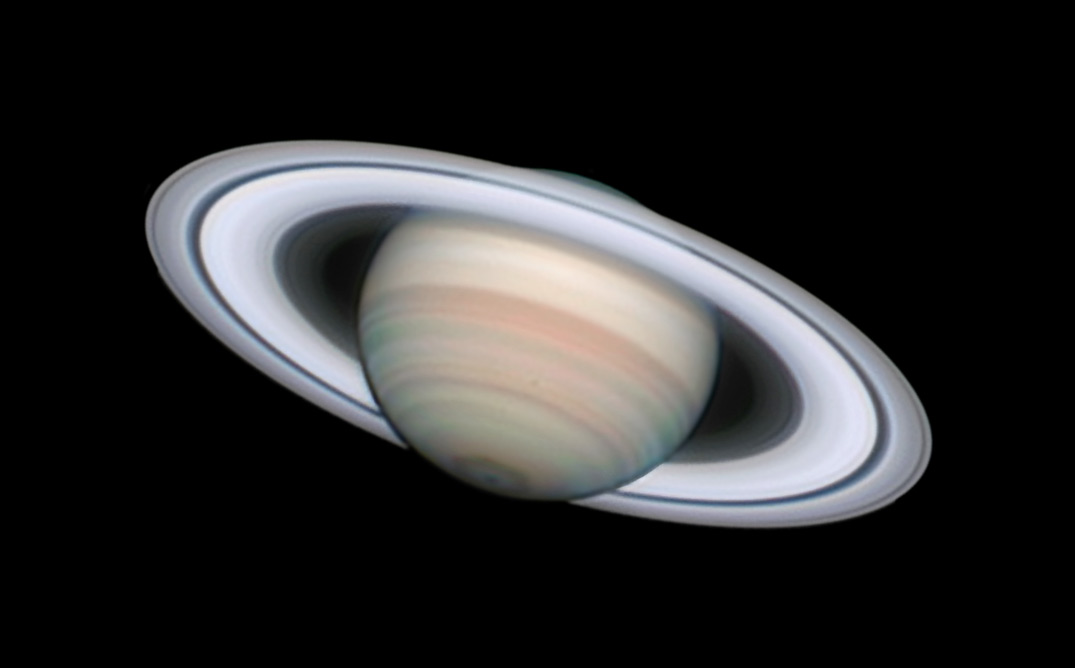
Uranus (magnitude 5.8, in Aries) is well up in the east by midnight or 1 a.m. daylight-saving time, east of Mars.
Neptune (magnitude 7.8, in Aquarius) is higher in the southeast by that time. Finder charts for Uranus and Neptune.
All descriptions that relate to your horizon — including the words up, down, right, and left — are written for the world's mid-northern latitudes. Descriptions that also depend on longitude (mainly Moon positions) are for North America.
Eastern Daylight Time, EDT, is Universal Time (also known as UT, UTC, GMT, or Z time) minus 4 hours.
Want to become a better astronomer? Learn your way around the constellations. They're the key to locating everything fainter and deeper to hunt with binoculars or a telescope.
This is an outdoor nature hobby. For an easy-to-use constellation guide covering the whole evening sky, use the big monthly map in the center of each issue of Sky & Telescope, the essential magazine of astronomy.
Once you get a telescope, to put it to good use you'll need a detailed, large-scale sky atlas (set of charts). The basic standard is the Pocket Sky Atlas (in either the original or Jumbo Edition), which shows stars to magnitude 7.6.

Next up is the larger and deeper Sky Atlas 2000.0, plotting stars to magnitude 8.5; nearly three times as many. The next up, once you know your way around, are the even larger Interstellarum atlas (stars to magnitude 9.5) or Uranometria 2000.0 (stars to magnitude 9.75). And read how to use sky charts with a telescope.
You'll also want a good deep-sky guidebook, such as Sky Atlas 2000.0 Companion by Strong and Sinnott, or the bigger (and illustrated) Night Sky Observer's Guide by Kepple and Sanner.
Can a computerized telescope replace charts? Not for beginners, I don't think, and not on mounts and tripods that are less than top-quality mechanically, meaning heavy and expensive. And as Terence Dickinson and Alan Dyer say in their Backyard Astronomer's Guide, "A full appreciation of the universe cannot come without developing the skills to find things in the sky and understanding how the sky works. This knowledge comes only by spending time under the stars with star maps in hand."
![]() Audio sky tour. Out under the evening sky with your
Audio sky tour. Out under the evening sky with your
earbuds in place, listen to Kelly Beatty's monthly
podcast tour of the heavens above. It's free.
"The dangers of not thinking clearly are much greater now than ever before. It's not that there's something new in our way of thinking, it's that credulous and confused thinking can be much more lethal in ways it was never before."
— Carl Sagan, 1996
"Facts are stubborn things."
— John Adams, 1770
 3
3








Comments
Rod
August 21, 2020 at 9:13 am
mary beth et al. Mars is starting to show off now, especially after midnight. On 18-August-2020, I enjoyed some very good views of Mars using my 90-mm telescope at 200x.
[Observed 0005-0110 EDT/0405 UT - 0510 UT. Surprising amount of surface detail visible at 200x tonight near and after 0100 EDT, especially Nirgal Vallis dark areas. South polar cap distinct too. Mars had better altitude or elevation angle after 0045 EDT or 0445 UT, transit near 0456 EDT or 0856 UT. Nu Piscium and Mu Piscium stars visible unaided eyes – better and easier to see near 0100 EDT as Mars altitude improved. 10x50 binoculars easy to see both stars. This is a good position fix for Mars observing early this morning on 18-August-2020. Mars framed by Nu Piscium and Mu Piscium stars moving eastward in Pisces. Mars gibbous shape, 88.9% illuminated. I used TeleVue 1.8x Barlow lens with TeleVue Nagler 9-mm eyepiece for 200x. Mars light orange-yellow color. Earth rotation apparent. Keep Mars centered in FOV. Mars moves quickly across the eyepiece FOV at 200x due to Earth's rotation.]
You must be logged in to post a comment.
mary beth
August 25, 2020 at 12:49 am
Glad you had such a success viewing Mars. How much longer will the viewing be most favorable?
Tonight I noticed that at about 10:30 PM CDT, Antares in the Southwest and Arcturus in the Northwest were at about the same declination (I think that’s the correct term…?). The almost quarter moon was a little closer to Antares but added a nice touch to the scene!
You must be logged in to post a comment.
Rod
August 25, 2020 at 1:48 am
mary beth, Mars is approaching opposition 13-Oct so the views are getting better and better 🙂 The October issue of Sky & Telescope has the full report now. I enjoyed views of Mars again this morning until a bit after 0100 EDT. 71x to 100x views and using #23A red filter too. Hellas Planitia area, circular area, and south polar cap visible at 100x. Nu Piscium star ~ 46' angular separation from Mars this morning in Pisces. I could see the 4.45 magnitude star with unaided eyes and at 71x, both Mars and the star (along with a number of stars) visible in the FOV. So far, fun Mars observing season using small telescopes. I plan to put my 10-inch on Mars soon and view 216 to 300x views.
You must be logged in to post a comment.
You must be logged in to post a comment.